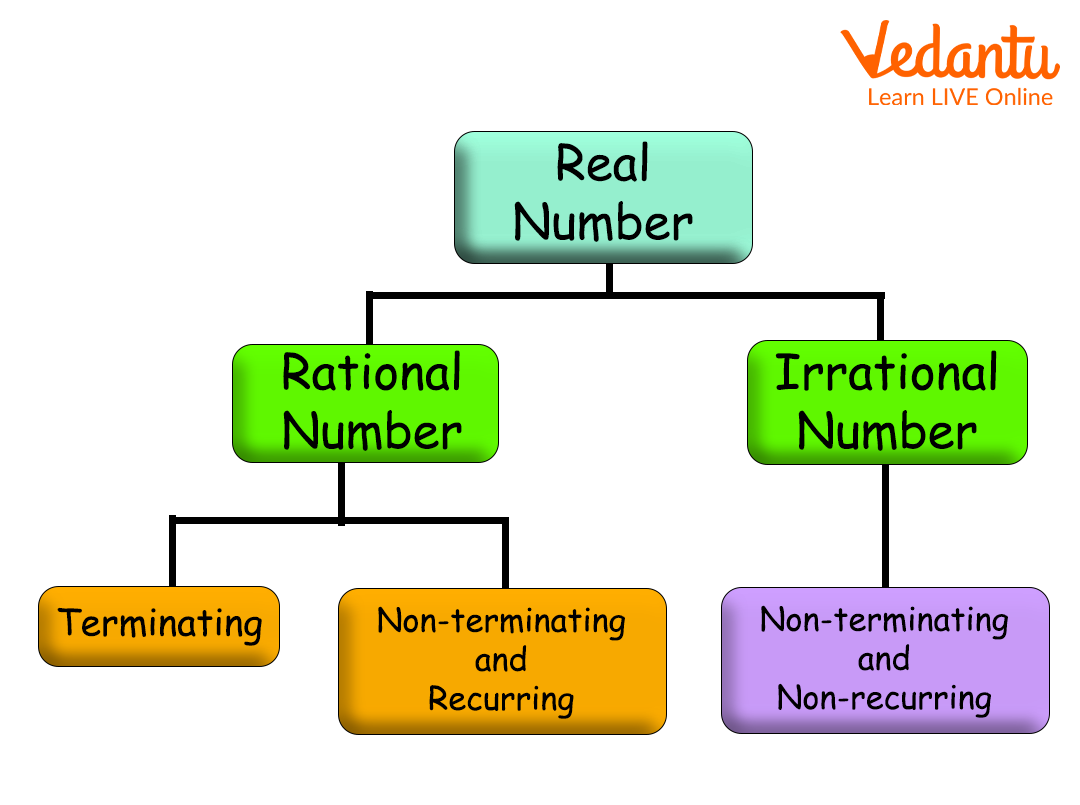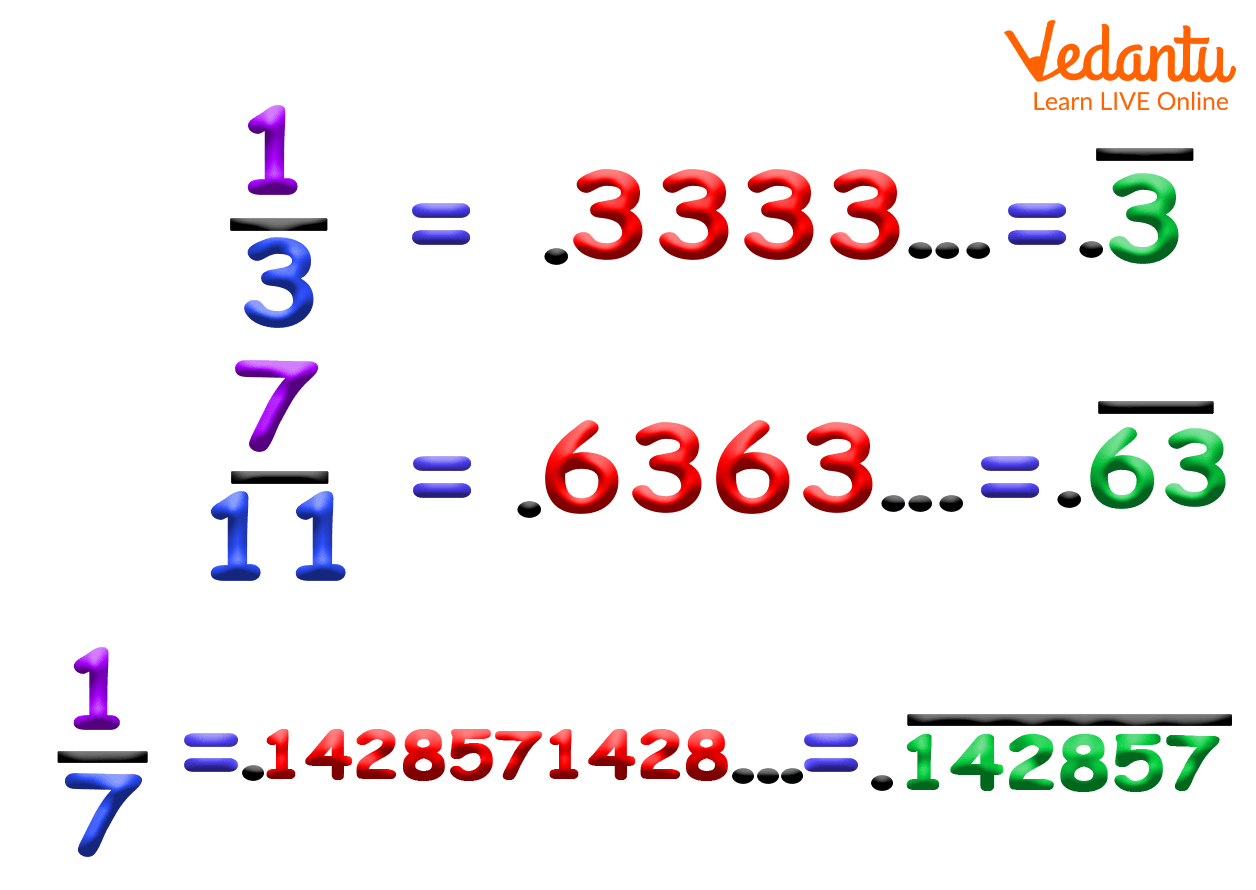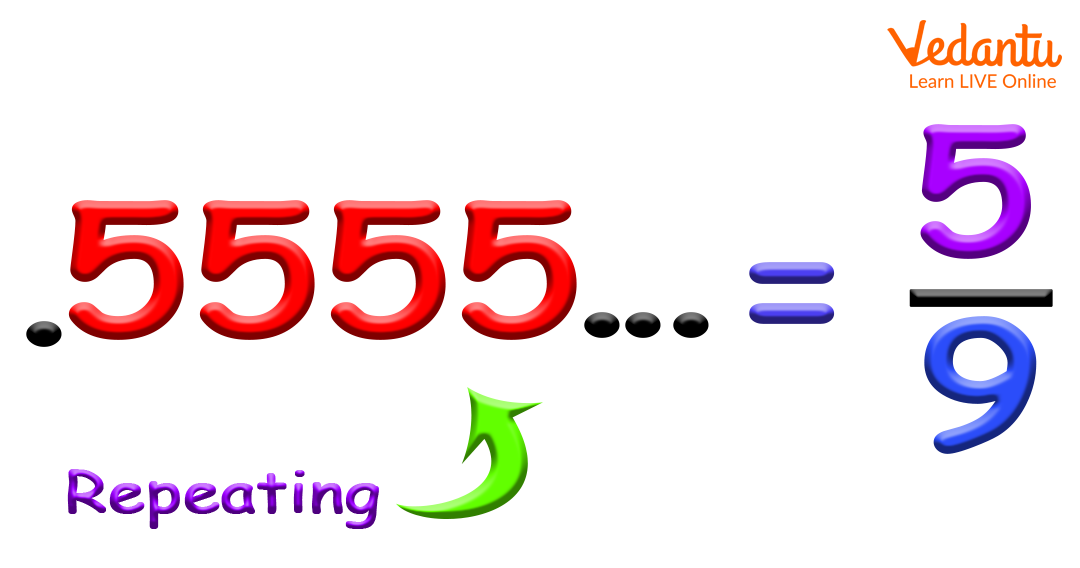




How to Identify and Solve Recurring Numbers in Maths
The numbers which tend to repeat after a decimal point infinitely in a uniform manner are known as recurring numbers, also known as recurring or repeating decimal numbers. After a decimal point, two types of numbers are found, recurring and non-recurring. Some recurring numbers examples are -
\[\frac{1}{6} = 0.1666666.....\] Here 6 repeats forever,
\[\frac{{10}}{3} = 3.3333333.....\] Here 3 repeats forever,
\[\frac{1}{7} = 0.142857142857142857\] Here 142857 repeats forever, etc.
What are Recurring Numbers?
Recurring numbers or repeating decimal numbers are those numbers whose digits repeat their values uniformly and infinitely after a decimal point, and the repeated digit or set of digits is never zero. The repeated numbers are fixed and they repeat in a continuous manner. Since it is one of the types of decimal numbers, there are other types of decimal numbers too.
Normally, decimal numbers can be divided into two categories:
Recurring decimal number– Numbers whose digits repeat infinitely.
Non-recurring decimal number– Numbers whose digit does not repeat.

Types of Real Numbers
Representation of Recurring Numbers
Recurring numbers are represented by putting bars above the repeating digit. Instead of a dash we can also put a dot on the top of the repeating digit.

Conversion of Recurring Numbers
Conversion of Recurring Numbers to Fractions
In recurring numbers, the decimal digits are repeated. Let’s discuss some points for the conversion of recurring decimal into fraction.
Let us consider a number X, which is a recurring decimal.
Then count the number of recurring digits. Name them y.
Now, recurring decimals are multiplied by powers of 10 according to decimal number.
To eliminate the recurring number, we have to subtract the answer of point 1 from point 3.
Now, after solving the expression, we will get the value of X.
Expresses the value of X as a fraction.
Let’s understand this with the help of recurring numbers examples.
Let the value of X be equal to 0.989898
from the value of X we clearly see that two digits are repeating.
so the number of recurring digits is 2.
Multiply 10 to power 2 which is equal to 100.
Now \[100{\rm{X = 98}}{\rm{.98989898}}\]
After subtracting the value of x from the above equation, we get \[99{\rm{X = 98}}\]
After solving this, we get the value of X, which is equal to,
,\[{\rm{X}} = \frac{{98}}{{99}}\]

Conversion of Recurring Numbers to Fractions
Are Recurring Numbers Rational Numbers?
We know that rational numbers are the ratio of two integers where the denominator is not equal to 0. Representation of rational numbers is \[\frac{{\rm{p}}}{{\rm{q}}}\] where p and q are integers and q is not equal to 0. So we know that in maths there are several ways to represent a number.
Let's take an example. \[\frac{1}{3} = 0.33....\] where \[\frac{1}{3}\] is a rational number and 0.333… is a recurring number. Actually recurring numbers are rational numbers because these numbers have repeating digits after decimal.
Non Terminating and Non Recurring Numbers
All irrational numbers are non-terminating and non-recurring decimal numbers. Root numbers cannot be expressed in the form of fractions because the value of the decimal in the recurring number can go up to infinity so for solving this we have to do complicated calculations. Because these numbers are non-terminating and non-repeating decimals,example 1.414211356… This is the value of under root two, which is non- terminating and non-repeating.
Solved Examples
1. Find the fraction form of 1.555….
Ans: Let us consider the number x.
Where x is equal to 1.555….
\[{\rm{x}} = 1.555.....\].————(1)
Now in this number only one digit is repeating, that is 5.
So we multiply x by 10
\[10{\rm{x}} = 15.55\]————(2)
Subtract equation (1) from equation (2)
\[10{\rm{x}} - {\rm{x}} = 15.55 - 1.55\]
\[9{\rm{x}} = 14\]
\[{\rm{x}} = \frac{14}{9}\]
So here we convert given recurring number into rational number
2. Find the fraction form of 15.34545….
Ans: Let us consider the number x.
Where x is equal to 15.34545…
\[{\rm{x}} = 15.34545\]
x=15.34545————(1)
Here two digits are repeating, that is 45.
Now multiply the equation by 1000.
\[1000{\rm{x}} = 15345.4545.....\]————(2)
Now we have to keep the same repeating digit on the right side of the decimal, so multiply equation (1) by 10
\[10{\rm{x}} = 153.4545.....\]————(3)
Subtracting equation(3) from equation (2)
\[990{\rm{x}} =15192\]
\[{\rm{x}} =\frac{{15192}}{{990}}\]
\[{\rm{x}} = \frac{{844}}{{55}}\]
Conclusion
So, in this article we learned about recurring numbers and how they are represented, how recurring numbers are converted into rational numbers. We also learned some interesting facts about rational numbers and solved non terminating recurring numbers examples. Afterwards, we can solve problems of recurring numbers.
FAQs on Recurring Numbers: Definition, Tricks & Practice
1. What are recurring numbers in Maths?
In mathematics, recurring numbers, also known as repeating decimals, are rational numbers that have a sequence of digits that repeats infinitely after the decimal point. For instance, the fraction 1/3 results in the decimal 0.333..., where the digit '3' is the recurring part. These are a type of non-terminating decimal because the digits continue forever.
2. What is the key difference between recurring and non-recurring decimals?
The key difference lies in their predictability and classification. Recurring decimals have a digit or a block of digits that repeats in a predictable pattern infinitely (e.g., 0.121212...). Because of this pattern, they can always be expressed as a fraction and are therefore rational numbers. In contrast, non-recurring, non-terminating decimals have digits that go on forever without any repeating pattern (e.g., the value of Pi, 3.14159...). These numbers cannot be written as simple fractions and are known as irrational numbers.
3. How are recurring numbers represented using special notation?
To simplify the writing of recurring numbers, a special notation is used. A dot (vinculum) is placed above the repeating digit or a bar is placed over the sequence of repeating digits.
- For a single repeating digit, like in 2/3 = 0.666..., it is written as 0.6̇ or 0.6̅.
- For a sequence of repeating digits, like in 1/7 = 0.142857142857..., it is written as 0.1̇42857̇ or 0.142857.
4. Can you provide a few examples of recurring numbers?
Certainly. Recurring numbers arise from fractions whose denominators have prime factors other than 2 or 5. Here are a few examples:
- 1/6 = 0.1666... (Here, '6' is the recurring digit). This is an example of a mixed recurring decimal.
- 4/11 = 0.363636... (Here, '36' is the repeating block). This is a pure recurring decimal.
- 5/12 = 0.41666... (Here, '1' is non-recurring, but '6' repeats infinitely).
5. How do you convert a recurring decimal into its fractional form (p/q)?
To convert a recurring decimal to a fraction, you can use an algebraic method. Let's take 0.777... as an example. First, let x = 0.777.... Then, multiply by 10 to shift the decimal point: 10x = 7.777.... Now, subtract the first equation from the second: 10x - x = (7.777...) - (0.777...). This simplifies to 9x = 7, which gives x = 7/9. This method can be adapted for any recurring decimal.
6. Why are all recurring decimals classified as rational numbers?
All recurring decimals are classified as rational numbers because they can always be expressed as a ratio of two integers, in the p/q form where q is not zero. The repeating pattern allows us to use algebraic manipulation (as shown in the conversion method) to eliminate the infinite decimal part and isolate a whole number relationship. This process guarantees that a fractional equivalent can always be found, which is the very definition of a rational number. Irrational numbers, by contrast, lack this repeating pattern, making such conversion impossible.
7. What is the mathematical reason a fraction results in a recurring decimal instead of a terminating one?
The type of decimal a fraction produces is determined by the prime factors of its denominator when the fraction is in its simplest form. A fraction will result in a terminating decimal if and only if the prime factors of the denominator are exclusively 2s and/or 5s. If the denominator has any other prime factor (such as 3, 7, 11, etc.), the division process will never resolve to a remainder of zero and will instead fall into a repeating cycle, producing a recurring decimal.
8. Can a recurring decimal ever be a negative number?
Yes, absolutely. Just as there are negative integers and negative terminating decimals, there are negative recurring decimals. They represent negative rational numbers. For example, the fraction -2/3 is equal to -0.666..., which is a negative recurring decimal. The negative sign simply indicates the number's position on the number line to the left of zero, while the recurring digits define its magnitude.

















